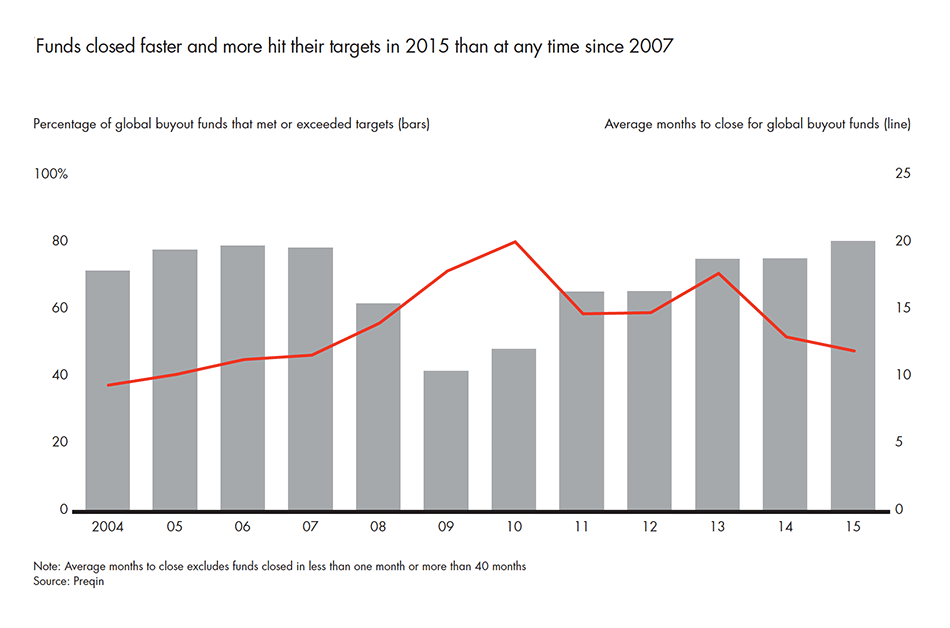Forbes.com
This article originally appeared on Forbes.com.
The tidal wave of distributions flowing back to limited partners (LPs) over the past five years has left many significantly underweighted in their allocations to private equity (PE), historically their best-performing asset class. But as we discuss in Bain & Company’s Global Private Equity Report 2016, new PE funds are closing faster and the share of those that met or exceeded their fund-raising targets was higher than at any time since the precrisis boom of 2007.

As a direct result, many LPs have been turning to novel ways to invest in private equity:
The expanding penumbra of shadow capital. Coinvesting alongside a general partner (GP) or making direct investments that bypass a GP entirely are two fast-developing approaches that are growing in popularity with LPs. This shadow capital does not figure in the totals raised by PE funds, but it is having a big influence on GP-LP relations and the evolution of the industry overall. LPs like coinvesting because anteing up additional capital can buy them access to an elite GP—or squeeze concessions from one with middling performance—by putting money in its new fund and then writing another check that lets the LP ride shotgun with the fund while paying a far lower fee to the GP, taking a smaller bite out of returns.
Alongside those undeniable benefits of being able to deploy more capital in PE at lower cost, however, come some real concerns. For instance, when a big chunk of nontraditional money from LPs is hidden in the shadows of a GP’s new fund, other LP participants, typically smaller or mid-sized institutions, can be left wondering just how much capital the GP will ultimately need to put to work—and precisely whose interests the GP will end up representing. Yet, despite those potential frictions, coinvestments took a big step forward last year. On an annualized basis, shadow capital invested in PE during 2015 totaled an estimated $161 billion, or the equivalent of 26% of the year’s traditional capital raised, according to a 2015 report by Triago, a leading PE industry fund-raising adviser.
Secondaries get a new look. Another novel way LPs are choosing to participate in PE is through their increasing use of the secondary market to deploy capital by actively trading shares in existing PE funds. Traditionally, the buying and selling of secondary interests has been the narrow domain of specialist funds created solely for that purpose. The extent to which LPs were active directly in secondaries had been to liquidate a stake in an established fund, either because they needed the cash or because they lost confidence that the GP would generate a hoped-for return. For their part, conventional LPs who bought secondaries often sought to take advantage of steep discounts they could command, but when doing so they knew they had to take care to check under the hood of a fund that another LP was eager to sell.
Over the past few years, secondaries have almost entirely lost that stigma. In a recent report on PE liquidity, SEI, a US asset-management advisory firm, reported that 58% of LPs acknowledged having bought or sold assets on the secondary market. Indeed, trading in secondaries has become a potent portfolio management tool. In addition to allowing LPs to use un-invested capital to increase their exposure to PE, secondaries also enable them to better diversify their holdings across several fund vintages. The number of nontraditional buyers in the secondary market—a group that includes regular LPs looking to firm up their PE allocations—nearly doubled since 2013, to 485 last year.
LPs are willing to broaden their exposure to PE coinvesting, trading in secondaries and other novel approaches because they know that the disciplines of PE value creation are well suited for today’s market turmoil and will likely better withstand the headwinds of an uncertain economy ahead. PE has served LPs well in good and bad times in the past, and confidence is strong that it will continue to do so.
Hugh MacArthur, Graham Elton, Dan Haas and Suvir Varma are leaders of Bain & Company’s Private Equity Group.
Carl Evander is a principal in Bain’s Private Equity Group.
